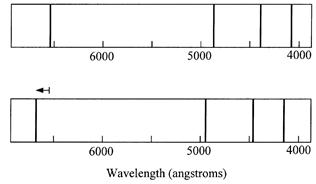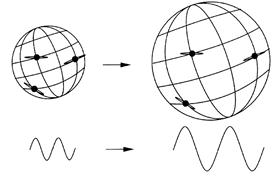


 الفيزياء الكلاسيكية
الفيزياء الكلاسيكية
 الكهربائية والمغناطيسية
الكهربائية والمغناطيسية
 علم البصريات
علم البصريات
 الفيزياء الحديثة
الفيزياء الحديثة
 النظرية النسبية
النظرية النسبية
 الفيزياء النووية
الفيزياء النووية
 فيزياء الحالة الصلبة
فيزياء الحالة الصلبة
 الليزر
الليزر
 علم الفلك
علم الفلك
 المجموعة الشمسية
المجموعة الشمسية
 الطاقة البديلة
الطاقة البديلة
 الفيزياء والعلوم الأخرى
الفيزياء والعلوم الأخرى
 مواضيع عامة في الفيزياء
مواضيع عامة في الفيزياء|
Read More
Date: 15-10-2015
Date: 11-10-2015
Date: 18-10-2015
|
Edwin Hubble

Redshifts
One aspect of Hubble's genius was his ability to take the incomplete work of others and carry it further with his own extensive and carefully planned observations. In one of his rare compliments for Hubble, Shapley said (more than a decade after Hubble's death), “Hubble, by the way, was an excellent observer, better than I. He was patient.” We have seen Hubble's masterful use of the Leavitt- Shapley method for measuring cosmic distances. His greatest achievement, probably the most important by an astronomer in the twentieth century, was inspired by a series of observations made in the 1910s by a largely self-taught astronomer named Vesto Slipher at the Lowell Observatory in Flagstaff, Arizona.
Slipher worked with a large refracting telescope equipped with a spectroscope, a device that analyzes light by spreading it into its rainbow components. He discovered that characteristic spectral lines in light received from galaxies were slightly shifted in wavelength from what is observed for the same lines in an earthly laboratory. When he observed the M31 galaxy, for example, the shift was toward short wavelengths, a “blueshift” because blue is on the short-wavelength end of the visible spectrum. Most of the galaxies Slipher observed exhibited “redshifts,” however, toward longer wavelengths. The terms “red” and “blue” do not denote actual colors, only the direction of the shift to longer or shorter wavelengths. Figure 1.1 illustrates the effect.
Slipher interpreted these wavelength shifts by referring to an effect first described in 1842 by Johann Doppler. The Doppler effect has several important manifestations, all connected with changes in wave behavior when the source and the observer of the waves move with respect to each other. In modern applications, a redshift of light represented by z is defined by
 (1)
(1)
in which λs is the wavelength of the light as it is emitted by the source, and λo is the longer wavelength of the light seen by the observer. The actual change in wavelength is λo - λs, and z calculates the fractional change. For redshifts, the wavelength λo is greater than λs, and z in equation (1) is positive. Equation (1) also applies to blueshifts, which reverse the situation: λo is less than λs, and z is negative.
If the relative speed v between observer and light source is not large, the Doppler connection between the redshift (or blueshift) z and the relative speed v is
 (2)
(2)

Figure 1.1. Wavelengths from the spectrum of light emitted by hydrogen. Above: as they appear normally. Below: the same wavelengths redshifted by about 2%, with z = 0.02. An angstrom is a very small measure of length, equal to 10-8 centimeter. Adapted with permission from John Hawley and Katherine Holcomb, Foundations of Modern Cosmology (New York: Oxford University Press, 1998), 263.
where c is the speed of light. A positive value of v calculated from this equation for a redshift suggests that the source of the light, say a galaxy, is moving away from the observing astronomer on Earth. Data reported by Slipher in 1914 and thereafter implied speeds of galactic recession from Earth as high as an astonishing 1,100 kilometers per second. Blueshifts that is, negative values of z are uncommon for galaxies; when they occur, they calculate negative relative speeds, meaning that the galaxy is approaching Earth.
In the late 1920s, Hubble got into the redshift business. Using Slipher's data at first, he plotted Doppler speeds of recession calculated with equation (2) against his own distance measurements. The plot showed that galactic recession speeds increase with distance: the more distant the galaxy, the faster it seems to move away from Earth. From inconclusive data published in 1929, Hubble guessed that there was a linear connection between the calculated speed of recession v of a galaxy and the distance l from Earth to the galaxy. The mathematical statement of this conjecture, as it is now written, is
v = Hl, (3)
in which H is a constant, now known as “Hubble's constant.” Written in terms of the redshift z, the equation is
 (4)
(4)
By 1931, Hubble had better data and more confidence in the linear relation expressed by equation (3). But he was cautious about accepting the reality of the recession speeds. He preferred to call them “apparent” speeds, and consider the linear law to be an “empirical relation between observed data.” Others saw the redshifts and the related recession speeds as evidence for a cosmology based on an expanding universe the idea that the universe is continually expanding at a rate that increases in proportion to distance.
The expansion carries the galaxies with it, and the result is a (possibly neverending) increase in distances among galaxies. Figure 1.2 gives an impression of the expansion, as it would appear if it occurred in a two-dimensional curved space rather than our own three dimensional space. Note that all points move

Figure 1.2. Above: an impression of an expanding universe as it might be seen in two dimensional curved space. The two-dimensional expansion is like the inflating of a balloon with the galaxies pasted on its surface. Below: the corresponding increase in the wavelength of light. Adapted with permission from John Hawley and Katherine Holcombe, Foundations of Modern Cosmology (New York: Oxford University Press, 1998), 282.
away from one another, and that there is no center of expansion. The wavy lines in the bottom part of the figure represent schematically part of a light wave and its stretching (redshifting) in spacetime with the expanding universe.
If it is appropriate to say that the expansion is driven by a force, that force is weak compared to the gravitational force within the confines of the solar system or a galaxy. So, as suggested by the figure, the galaxies themselves retain their gravity controlled shapes and do not necessarily expand.
Equation (2) has a shortcoming. The recession speed v, like other speeds, cannot exceed the speed of light c, and that seems to tell us that the redshift z cannot be greater than one. Yet redshifts approaching eight are now being reported. The trouble is that equation (2) does not recognize the requirements of special relativity. If the Doppler equation is made relativistic, it becomes
 (5)
(5)
for a universe with no curvature. This equation allows z to increase to infinity. (As v approaches c, 1 - v/c in equation [5] becomes very small, and division by the small number gives a very large value for z.)
Astronomers look outward in space and backward in time. Because light travels at a finite speed, it takes a finite time, possibly a very long time, to travel from a star or galaxy to Earth. If the distance to a galaxy is eight billion light years (a distance covered by the largest modern telescopes), the image of the galaxy recorded by the astronomer shows the galaxy not as it is now, but as it was eight billion years ago. And during the time a light ray was making its eight billion light year journey, the universe was expanding. The observed redshift gives a simple measure of the extent of that expansion. Rearrange equation (1) to

or
 (6)
(6)
Suppose we find that the light mentioned has the redshift z = 1. Then the last equation calculates λo/λs =2: the wavelength of the light doubled while it traveled from the galaxy to Earth, reflecting a twofold expansion of the universe during that time. The galaxy is finally zipping away from us on Earth at 180,000 kilometers per second.
Hubble and his talented assistant, Milton Humason, made many redshift observation following Hubble's initial analysis of Slipher's data. They extended the linear equation (3) to a distance of more than one hundred million light years and gave it a permanent and prominent place on the list of nature's most fundamental physical laws.
The Constant
Hubble's most important legacy is embodied in the law expressed by equation (3), called “Hubble's law.” The hallmark of the equation is the factor H, Hubble's constant. It is fundamental in cosmology because it expresses the rate of expansion of the universe. We can see that specifically by writing an equation for the expansion as expressed by the changing distance l between two galaxies, separated by, say, ten million light-years to make gravitational effects negligible,
l = l0R, (7)
in which l0 is the present separation between the galaxies, and R plays the role of a cosmic “scaling factor.” At the present time, R = 1 and l = l0, as assumed. At some time in the past, when the expansion was half what it is now, R = 1⁄2 and l = l0/2. At some time in the future, when the expansion has doubled, we will have R = 2 and l = 2l0.
The rate of the expansion, that is, its speed, is calculated as the time derivative dR/dt. Hubble's constant H is directly related to this rate, and takes us to the heart of the expansion problem. The connection is
 (8)
(8)
(Proof of this equation is not difficult. Take time derivatives on both sides of equation [7]; note that dl/dt is the same thing as the speed v in Hubble's law, equation [3]; then substitute for v from Hubble's law, and for l0 from equation [7].)
As modern cosmologists reconstruct it, the cosmic expansion began with the entire universe crunched into an extremely small volume. At that time, the scaling factor R was equal to zero or close to it. Something like a big bang initiated the expansion from the original crunch, and as we see it today, distant galaxies are flying away from one another according to Hubble's law. That scenario suggests using Hubble's law to calculate how long it has taken for the universe to reach its present state of expansion. If time began with a big bang, this calculation gives us the age of the universe.
Consider any two galaxies separated by a distance l and receding from each other at the speed v. If the speed is constant, the time to achieve that separation is simply l/v. (To take a homely example, suppose two cars are driving away from each other at the constant relative speed v = 50 miles per hour. If they start at the same point, they are separated by l = 100 miles in 1/v=100/50 hours.) We see from Hubble's law, v = Hl, that in the cosmic realm the 1/v ratio is equal to the reciprocal of Hubble's constant,

The time thus calculated, called the “Hubble time,” and represented tH,
 (9)
(9)
is an estimate of the age of the universe. It is not an accurate calculation because neither the speed of recession nor Hubble's constant is actually constant, as we have assumed. If the expansion accelerates, that is, if the speed increases with time, tH underestimates the age of the universe; if the expansion decelerates, the speed decreasing with time, tH overestimates the age of the universe.
For more than sixty years, astronomers have struggled with the task of measuring a reliable value of Hubble's constant. So far, they have met with only partial success because of the many difficulties inherent in measuring cosmic distances. Hubble's first measurement of his constant was in error by almost an order of magnitude because he did not realize that there is more than one kind of Cepheid variable star. In recent times, independent measurements of H have differed from each other by about 15 percent.
In the peculiar mixture of units favored by astronomers, a reliable average value of H seems to be about 65. That number requires two different units for distance: the v factor in Hubble's law is expressed in kilometers (per second) and the l factor in megaparsecs, another special astronomical distance unit (equal to 3.26 million light-years). When that violation of the rules learned in freshman physics for specifying units is repaired, the value of H calculates

as an approximate (apparently slightly high) age of the universe.
The Telescope
Hubble's final honor was posthumous: a great telescope was named after him. It is a space telescope that makes its observations with unprecedented clarity and wavelength range, because, from its vantage point in space, it avoids the distorting effects of Earth's atmosphere. The Hubble Space Telescope was launched in 1990. It contains a 94.5-inch primary mirror, cost about two billion dollars, and demands two hundred million dollars annually for maintenance costs.
For its first three years, the Hubble telescope threatened to be a spectacular failure. Due to an error in the manufacture of the mirror, unaccountably missed before the telescope was launched, the first images obtained were fuzzier than expected. A special shuttle mission in 1993 gave the telescope corrective optics and the vision originally desired. Since then, the Hubble telescope, like its namesake some fifty years earlier, has performed brilliantly.
A catalogue of the achievements of the Hubble telescope includes: close observation of a comet colliding with the planet Jupiter; observations suggesting that giant black holes are often located at the cores of galaxies; “deep field” views into space, penetrating more than twelve billion light-years and counting by extrapolation 120 billion galaxies in the observable universe, each containing many billions of stars; observations of collisions between galaxies; views of galaxies born less than a billion years after the big-bang event; calibration of standard distances used in calculating a value for the Hubble constant; and observations of distant supernovae (exploding stars), suggesting that expansion of the universe is accelerating.
No scientist has had a finer monument.



|
|
|
|
دخلت غرفة فنسيت ماذا تريد من داخلها.. خبير يفسر الحالة
|
|
|
|
|
|
|
ثورة طبية.. ابتكار أصغر جهاز لتنظيم ضربات القلب في العالم
|
|
|
|
|
|
|
العتبة العباسية المقدسة تقدم دعوة إلى كلية مزايا الجامعة للمشاركة في حفل التخرج المركزي الخامس
|
|
|